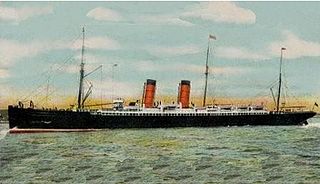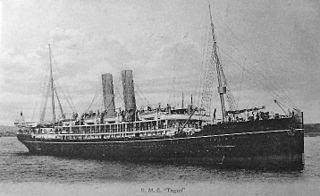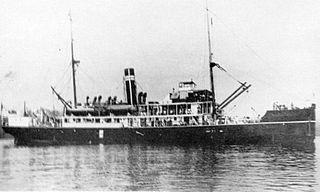SS Sangola was a steam cargo liner that was launched in Scotland in 1901, renamed Goshu Maru in 1923, and scrapped in Japan in 1933. She was one of a class of seven steamships that were built for the British India Steam Navigation Company (BI) in 1901 and 1902. From 1908 until 1910 she took Indian indentured labourers to Fiji.
Hereford was a 1456-ton iron sailing ship with two decks and one cemented bulkhead which was built in 1869 by J. Elder & Company at Glasgow for the Merchant Shipping Company of London. She was chartered by the New Zealand Shipping Company in the 1870s and made three voyages to Lyttelton, New Zealand with approximately three hundred emigrants each time. The first voyage in 1874 took 87 days, and the second took 80 days, arriving in Lyttelton on 19 January 1878. In 1881, she was stranded on Ingleby Reef near Port Phillip Heads, Melbourne, Victoria, Australia, and towed off on 12 March 1881 by a tug.
SS Vadala was a cargo steamship that was launched in Scotland in 1890, renamed Kenkon Maru No. 12 in 1913, and sank as the result of a collision in 1928. She was built for the British India Steam Navigation Company (BI). In 1895 she took Indian indentured labourers to Fiji. In 1899 was a troop ship in the Second Boer War. From 1913 she was in Japanese ownership.
SS Virawa was British India Steam Navigation Company (BI) steamship. She was launched in Scotland in 1890 and scrapped in India in 1921. Her trades included taking horses from Australia to India, and indentured labourers from India to Fiji and Trinidad. In 1899 she was a troop ship in the Second Boer War.
SS Fultala was a British India Steam Navigation Company (BI) steamship. She was built in England in 1890, operated mostly in the Indian Ocean, and was scrapped in India in 1923. She was a troop ship in the Second Boer War and the First World War. From 1901 to 1906 she took Indian indentured labourers to Fiji.
SS Wardha was a merchant steamship that was built in Scotland in the 1880s and scrapped in Italy in 1923. She was one of a pair of sister ships that were designed to carry cotton, but completed for the British India Steam Navigation Company (BI) to carry sugar. In 1899 she carried troops and cavalry horses for the Second Boer War. In the 1900s she took Indian indentured labourers to British Guiana and Fiji. From 1913 onward she passed through a succession of Italian owners, but kept her original name.
SS Santhia was a steam cargo liner that was launched in Scotland in 1901, renamed Saka Maru in 1923, and scrapped in Japan in 1935. She was one of a class of seven steamships that were built for the British India Steam Navigation Company (BI) in 1901 and 1902.
SS Chenab was a steamship that was built in England in 1911 and scrapped in Scotland in 1953. For nearly two decades she was part of Nourse Line, which carried Girmityas from India to colonies in the Caribbean and the Pacific. In 1914 she was requisitioned for service in the First World War.

RMS Etruria was a transatlantic ocean liner built by John Elder & Co of Glasgow, Scotland in 1884 for Cunard Line. Etruria and her sister ship Umbria were the last two Cunarders that were fitted with auxiliary sails. Both ships were among the fastest and largest liners then in service. Etruria was completed in March 1885, twelve weeks after Umbria, and entered service on the Liverpool – New York route.
SS Mulbera was a British India Steam Navigation Company (BI) turbine steamship that was built in 1922 and scrapped in 1954. She belonged to BI's "M" class of cargo liners. She was the last member of the class to be built, and the last to survive in service.
MV Domala was a British cargo liner that was launched in 1920 as Magvana, but completed in 1921 as Domala. She was the first major ocean-going passenger ship to be built in the United Kingdom as a motor ship.

RMS Magdalena was a British steamship that was built in 1889 as a Royal Mail Ship and ocean liner for the Royal Mail Steam Packet Company. In the First World War she served as the troop ship HMT Magdalena. After a long and successful civilian and military career she was scrapped in 1923.
SS Sirsa was a steel-hulled merchant steamship that was built in Scotland in 1883 and scrapped in Bombay in 1908. She spent her entire career with the British India Steam Navigation Company (BI).

Sampo was a Finnish state-owned steam-powered icebreaker. Built in 1898 by Sir W.G. Armstrong, Whitworth & Co Ltd in Newcastle upon Tyne, United Kingdom and named after a magical artifact from the Finnish mythology, she was the second state-owned icebreaker of Finland and the first European icebreaker equipped with a bow propeller. When Sampo was decommissioned and broken up in 1960, she was also the second last steam-powered icebreaker in the Finnish icebreaker fleet.
SS Hatarana was a cargo steamship that was built as part of an emergency shipbuilding programme during the First World War, and sunk without loss of life in the Battle of the Atlantic during the Second World War. She was built as War Sailor, one of a batch of cargo ships that the United Kingdom ordered from Japanese shipyards. She was renamed Hatarana in 1919 when she changed owners.

RMS Tahiti was a UK Royal Mail Ship, ocean liner and refrigerated cargo ship. She was launched in 1904 in Scotland as RMS Port Kingston for a subsidiary of Elder Dempster Lines. In 1911 the Union Steamship Company of New Zealand bought her and renamed her Tahiti.

SS Trent was a British steamship that was built in 1899 as an ocean liner for the Royal Mail Steam Packet Company (RMSP) service between England and the Caribbean. In the First World War she was a Royal Navy depot ship. She was scrapped in 1922.

The Jubilee class were a group of five passenger and cargo ocean liners built by Harland and Wolff at Belfast, for the White Star Line, specifically for the White Star Line's service from the UK to Australia on the Liverpool–Cape Town–Sydney route. The five ships in order of the dates they entered service were:

SS Sir Harvey Adamson was a coastal passenger steamship that was built in Scotland in 1914 for the British India Steam Navigation Company (BI). She traded along the coast of Burma until 1947, shen she disappeared in a gale in the Andaman Sea. No survivor or identifiable wreckage was ever found.
SS Warora was a merchant steamship that was built in Scotland in the 1880s and scrapped in India in 1911. She was one of a pair of sister ships that were designed for a Liverpool shipping company to carry cotton, but completed for the British India Steam Navigation Company (BI) to carry sugar. In 1899 she carried troops and cavalry horses for the Second Boer War. She was a troop ship again in the Boxer Rebellion.







